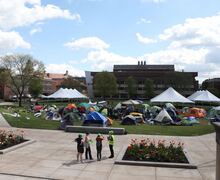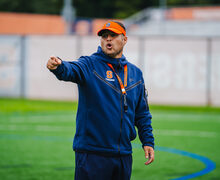Panelists discuss media portrayals of domestic terrorism
Michael Collier | Contributing Photographer
Remembrance Scholar and event moderator Gabrielle Caracciolo steered the conversation toward the responses of United States media to terrorism.
Several experts from Syracuse University and city organizations discussed how terrorism is portrayed in the media during a panel on Wednesday night.
SU hosted the “All-American Terrorism” panel as part of Remembrance Week, which honors the 35 SU students who died when Pan Am Flight 103 was bombed over Lockerbie, Scotland, in 1988.
Remembrance Scholar Gabrielle Caracciolo moderated the panel, focusing the conversation on the responses of U.S. media to terrorism. Panelists discussed perceptions of different races, ethnicities and religions in the country.
Mohamed Khater, former president of the Islamic Society of Central New York, said terrorism can generally be defined as a person or a group that causes harm to a civilian population in the hopes of political gain.
J. Elliott Lewis, an SU broadcast and digital journalism professor, said media coverage of terrorism often cancels out previously scheduled news for “wall-to-wall coverage.” The immediacy of breaking news coverage often results in the public receiving inaccurate facts, he said.
“When that happens, you as a viewer are not getting the news. You’re getting the news-getting process,” Lewis said.
Media coverage focuses more heavily on terrorist attacks if the perpetrators are Muslim, Khater said. The excessive coverage of attacks committed by members of minority groups cause a misperception of the groups as a whole, he said.

Jillian Juni, executive director of Syracuse Hillel, and Sgt. Brian Novitsky were panelists at the “All-American Terrorism” panel. Michael Collier | Contributing photographer
Khater and Jillian Juni, executive director of Syracuse Hillel, also discussed changing the narrative and improving education on different ethnicities, cultures and religions. Juni said sensitivity training and introducing people to different cultures is a good step to change the misperceptions of minority groups.
“People need to understand, if somebody did something, it doesn’t mean the whole race did it,” said Khater. “That is what we are doing in this country. We are generalizing everything.”
Juni said people don’t have to interact immediately with media reports on terrorism or events involving different ethnic groups. They can process information and search for additional sources to get the whole story instead, she said. There is always an opportunity to learn more from the cultures and religions of the people around you.
The current political environment in the U.S. encourages many people to speak up in favor of white supremacy, Khater said. White supremacists no longer fear sharing their views because they are confident the government will not take action against them, he said.
Rev. Bruce Burns of Hopps Memorial CME Church said, during his childhood, he was told “white was right.” This mentality often leads to minority races exercising a higher level of caution during their everyday lives, as they feel they represent their entire ethnicity through their actions, he said.
Students should be in an environment that forces them to meet peers of different races and religions at SU, Burns said. It’s common for individuals to interact through their prejudices and only spend time with people who come from a similar background, he said.
The university should push people to cross racial, ethnic and religious lines, Burns said.
“Without getting to know each other, we have to build a bridge and break out of the norm in order to get to know each other and unlearn what we’ve known our whole life,” Burns said.
Published on October 23, 2019 at 11:15 pm
Contact Sydney: [email protected]




